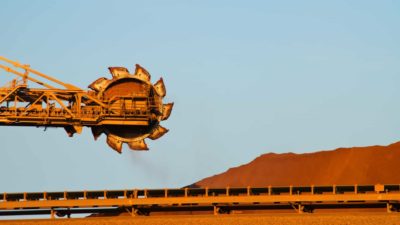If you own Rio Tinto Limited (ASX: RIO) shares or are considering investing in the S&P/ASX 200 Index (ASX: XJO) mining giant, you're likely keeping an eye on iron ore prices.
Iron ore, after all, brings in the lion's share of the miner's revenue.
When the price of the industrial metal heads higher, Rio Tinto shares tend to gain. And if you look at the overlaying price charts, you'll notice the same strong correlation in reverse.
Hence, the Rio Tinto share price hit all-time highs in mid-2021, when iron ore was fetching more than US$216 per tonne. And shares slid lower in the second half of the year as the iron ore price retreated to US$92 per tonne.
This year we saw Rio Tinto shares leap higher again. Shares reached $127.85 on 3 March amid rebounding iron ore prices, which hit US$161 per tonne in the first week of April.
Today, iron ore is fetching US$94 per tonne. And the Rio Tinto share price stands at $92.67, after paying out some outsized dividends this calendar year.
So, what's all this about a divergent outlook between Commonwealth Bank of Australia (ASX: CBA) analysts and the Federal government?
I'm glad you asked!
Where to next for iron ore prices?
In attempting to forecast its own future revenue stream, the Federal budget predicts a big drop in iron ore price, to US$55 per tonne (Free on Board (FOB) Australia) by the end of Q1 2023.
As outlined above, that kind of fall in iron ore prices would throw up some strong headwinds for Rio Tinto shares.
However, the analysts at CBA have a more bullish prediction for iron ore, at least over the medium term.
In CBA's Economic Insights report, published earlier this week, the bank stated, "We think that the Government's forecasts for Australia's key mining and energy commodities in the coming years are broadly too conservative."
According to the report:
The Budget's iron ore price forecast is lower than our outlook through the outlook period. The differences though lessen in later years. The difference reflects our view that prices will only gradually fall to $US60/t-$US65/t (FOB Australia) by late 2026/27 following a volatile year ahead.
Spot prices have come under pressure as China's property downturn weighs on demand. Policy in China remains the key driver of prices, particularly China's COVID-zero policy.
As for the kind of support Rio Tinto shares can expect from the iron ore price next year, CBA said:
We broadly expect iron ore prices to bottom in Q1 2023 as China's COVID-zero policy continues to weigh on demand. A shift away from China's COVID-zero by the end of March 2023 should see iron ore prices lift in the following quarters.
How have Rio Tinto shares been performing longer term?
Atop some healthy dividend payouts, Rio Tinto shares have gained 32% over the past five years. That compares to a 16% gain posted by the ASX 200 over that same time.









